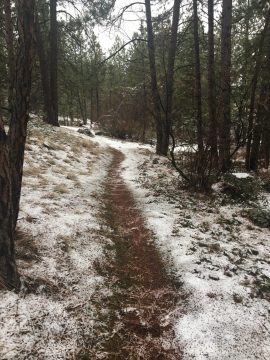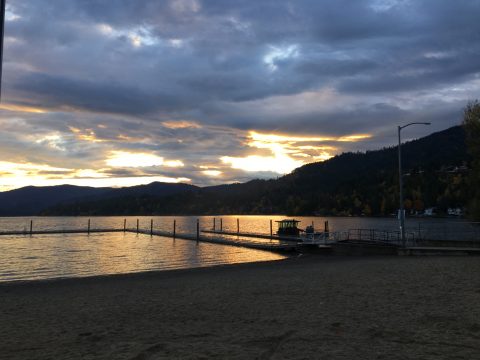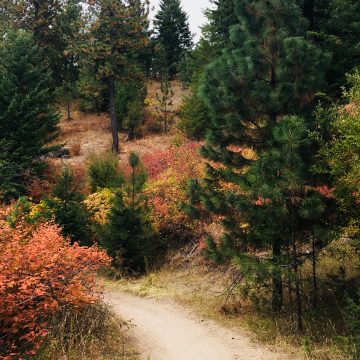[cherry_row]
[cherry_col size_md=”12″]

By HPRS Staff Columnist Christopher Mellot
I decided to run the Stories Ultra 30-Hour after I had come off possibly two of my greatest running achievements to date. I had finished my first 50-mile race at Badger Mountain Challenge in Richland Washington and minted a new personal record at the Priest Lake 50K in Priest Lake Idaho along with a top 10 overall. Confidence in my abilities was at an all-time high. I felt that the next challenge had to be a hundred miles. I thought about running one in September or October but decided to hold out for a more significant training block and because a fall hundred miler did not fit into my life.
Stories was an obvious choice for me to make a first attempt at the distance. The course runs on loops, and is easy for friends, family, and crew to see me without chasing me from aid station to aid station. It is a loop course, but a unique loop course with distinct loops and not the same two-mile stretch of trail for the entire thing. The elevation was manageable as I had just finished Badger Mountain with almost eight thousand feet of climbing and 100-Miles at Stories has about eleven thousand feet and some change.

I chose this race for its location as well. I know Colorado Springs, it was my home for 27 years. I have friends and family that can crew and provide cheers and cajoling as I run. I also chose this race because it is so early in the year. If things go off the rail and I don’t accomplish my goals, then I still have a solid window to train and attempt again before 2019 closes out.
July 2nd, 2018. It seems like ages ago having just closed out 2018. July 2nd is the day that I officially started my training block for Stories. 222 days from the start of this project to the start line. I currently have a 50-mile race, three 50Ks, and five marathons along with a multitude of other challenging races ranging from the Pikes Peak Ascent to 25Ks. I have no earthly idea if I can run 100 miles in 30 hours. I determined that I was ready because why the fuck not. I am the navigator of my own ship. I choose to adventure into the unknown. The unknown of my soul, of my physical capabilities and mental fortitude. I decided to dedicate the last seven months to this endeavor, to the training, to test my perceived limits and to explore the potential of who I could be as a runner.
“Eighty percent of success is showing up.” – Woody Allen
When I ran my first 50K, I ran to finish it. When I ran my second, I followed a training plan, and I wanted to win and scrambled together some of my biggest weeks, often topping 60 miles, but felt broken and tired when I raced. I ended that second 50K in seventh overall but 40 minutes off my goal time and 25 minutes off a PR and unsatisfied. I ran Badger mountain on less weekly mileage and felt fit and fresh when I raced. I had a dream entry into the longer races. For Stories, I created a training plan that focused on fewer miles. It had the traditional back to back long runs which I take as suggestions. I believe that running everyday balances some of the benefits of the back to back long runs. I created my training plan base using the HPRS Training Plan Generator. I edited it to fit my needs. I also added speed workouts, and hill intervals to compensate for some of the lower mileage. An important part of this training was also time on feet and practicing running in the dark.
Hill Intervals: On a treadmill run two minutes at 2% incline and then run slower pace at max elevation for 2- 6 minutes and repeat. I did this usually for about 4 miles.
Speed workouts: On a treadmill run two minutes at 5K or slightly faster pace then run two minutes at a comfortable pace. I repeated until I felt my form deteriorating or 40 minutes whatever came first.
Time on feet: A critical metric for me. I counted all my walks, runs with Diesel regardless of a mile per hour time. I also stood at my desk at work a few hours each week in addition to the running and walking.
Running in the dark: I have read enough about races and ultras to know that you have to run in the dark. Race reports stress that running in the dark is a skill that needs to be practiced. I intentionally did much of my running late at night outside to get used to my headlamp and what running with it is like.

My training had some fresh highlights. I did a few adventure runs where I picked a direction and just followed trails until I got home. As part of my training, I ran marathons on back-to-back days. I also ran some other races which I had some success in. I wrote a weekly “chapter” about each week of training and will someday get around to editing them, but if you want an unfiltered view of each week, you can check out The Stories Project. If you are a numbers person and want to see how each day went, how each week went then my Stories Ultra Training Log will give you some of the gritty details, or you can find me on Garmin or Strava.
My training indeed wasn’t perfect, but I showed up every day, literally every day for more than a half a year I showed up and forged a new version of me. One that will show up at the starting line and plans to battle with everything in me for thirty hours.
“Everything is a learning process: any time you fall over, it’s just teaching you to stand up the next time.” – Joel Edgerton
There are so many things that can go wrong training for an ultra that half the battle is showing up to the starting line healthy. With a little more than four weeks left until I toe the starting line, my training is where I want it to be. I am feeling healthy, excited, and most important I am feeling confident.
Almost every week of training I have learned a valuable lesson. Sometimes these are profound enlightenment and other weeks they are ideas that I have rediscovered during this training block.
One of the themes that screamed at me from multiple chapters was to take advantage of time. If you know you can get up early and get out for a long run, then do it; if you get a free day off from work, then head out and get an adventure in. Take advantage of time.
Power Hiking. When I first started running and choosing to run challenging races I always thought that power hiking was something you just did when you slowed down from running; a middle gear between running a walking. I practiced power hiking. At the USATF 30K Trail Championships, I power hiked a long climb and passed people that had tried to run it and then walked. If you ask me how many times my Dad has beaten me in a race that we both ran our best it would be one. One race, the Pikes Peak Ascent. Dad wasn’t a better runner than me, he wasn’t faster than me, but he could power hike faster than pretty much anyone and beat me by over 16 minutes. Practice your power hiking.
Practice with precisely what you want to wear. I have about six complete outfits that I know I can run Stories in. They range from shorts and t-shirt to clothing for below freezing weather. I have run hundreds of miles in these clothes, and they might never smell “fresh” again, but I know that they will work for the race.
Sometimes you need a hard reset. I have really never stopped in a race and have never really taken a “down” week in training. I did both during this training block. I did 80 miles and back to back marathons, and then next week I did 30 miles. I have never felt better getting back into training after that 30-mile week. At mile 18 or so of the second marathon. I was struggling hardcore. I was struggling to feel like I was moving forward with even a walk, so I stopped. I stopped, used the bathroom, ate some food and drank some water. Didn’t also try to move forward for three or four minutes and all of the sudden I was ready to go again. I just needed a hard reset.
Find an anti-chafe salve. You may have never needed it before but have some just in case. I can tell you that your shorts cutting into your legs or walking around like you just rode a horse on a cattle drive is a terrible feeling, and the shower you thought was going to help is scalding death water. Find some anti-chafe stuff.
Practice for the race. Obviously, that makes sense. Run areas similar to the areas you are going to be running in the race. Practice with your nutrition and try a bunch of other things while you are at it, so you know what will not work. Practice running in the dark. Running trails by headlamp is not an easy task, so you have to practice it.
Schedule tests of fitness. I am feeling confident in my training because I had some scheduled tests of fitness. While I was in Colorado Springs this summer, I ran 14 miles that included the incline (37 minutes if you were wondering my time up the incline) I also ran the USATF 30K Trail Championships. In September I ran a half marathon with a tough climb at the beginning to see where my climbing was at. In October I ran the two marathons in two days, and I finished 2018 with a Christmas Training Camp, and a New Years Training Camp, where I had four days off for each holiday and ran 10 miles a day minimum for four days straight. Schedule tests of fitness that will help you know where you are and hopefully build your confidence.
The last thing I learned or got closer to perfecting is spending time in my head. It’s a mess in my head. I spent time thinking about how to manage my life, my running, writing, and how I am going to survive the low points of a run and the weak points that are undoubtedly coming with this race. I have read enough reports to think about the mental aspect of our sport. Some of the tools I employ during runs and plan to use during Stories are…

Mantras: Smooth, Strong and Steady. This mantra is important because it says nothing speed but to remain as close to good form as I can and remain healthy and steady. I am thinking more tortoise than hare here.
Running Math: I hate math. My fiance majored in it and yet I can hardly stomach basic math, but when I run I do the math. I try to figure out the math for all sorts of scenarios like running a 5:00-minute mile downhill or taking 50 minutes to do a long mile climb.
Writing: When I am out running, I am often thinking about what to write, how to write it, what words I want to use, and how I can sprinkle a few curse words across what I write. I try to keep the good ideas in my mind while others are just fleeting thoughts.
This training block has taught me so many things about myself and fully believe I have become a better person, a better runner as a result of taking on the challenge. I am not the same person I was in July. The process of running and writing about it each day has been incredible, and while I may not reach my running potential at Stories, I may fail at the running bit; however, I have expanded my potential no matter what.
The future:
With less than 35 days until I get a chance to embrace the unknown to cast off from the shackles of the known and sail uncharted waters. I have processed all the training and work that has gone into this race, but besides wanting to get to 100 miles, I haven’t expressed what I want out of this race. First I want to experience a Human Potential Running Series race. I have been working with Sherpa John for about a year writing stuff, but I haven’t run one of his races. I am looking forward to doing it at Stories and sitting down and chatting with him. He gave me an opportunity to write, and it honestly was one of the highlights of 2018 for me. I am stoked to experience the comradery of Human Potential Running Series. I watched Regfest, and I tune into the water cooler and get to experience the energy there, but I am excited to experience it in person.
I want my friends to experience me in my element. Some of them have seen me run or come to races, but the majority of them haven’t seen me race or why I am so enthralled with ultra running and the community. With Stories being in my hometown I am expecting to see quite a few friends at the aid station as I loop around. Outside of the community and running 100 miles I have a hierarchy of goals, like a pyramid. The base being the most basic of goals, and the pinnacle is the dream goal.
Run 100+ miles, take the course record and win
Run 100 miles and place in the top ten
Run 100 miles
Run 100K
Run a distance PR
Run all 30 hours
Don’t get seriously injured
Don’t die
With tens of thousands of feet in elevation climbed, thousands of miles, hundreds of cups of coffee, thirty-two weekly updates, several pairs of shoes all come down to this one race. I am going all in. I am going to risk going too far to find out who I am and how far I can go.
“Only those who will risk going too far can possibly find out how far one can go.”― T.S. Eliot
[/cherry_col]
[/cherry_row]
